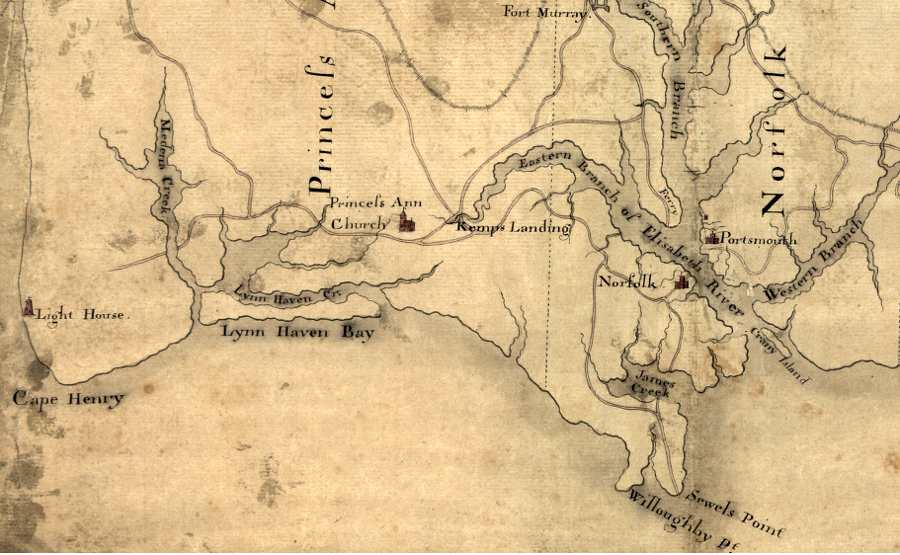
quickly-built fortifications at Craney Island blocked a British attempt to seize the Gosport Navy Yard in 1814
Source: Library of Congress, Part of the Province of Virginia (1791)

quickly-built fortifications at Craney Island blocked a British attempt to seize the Gosport Navy Yard in 1814
Source: Library of Congress, Part of the Province of Virginia (1791)
On June 18, 1812, President Madison signed a declaration of war against Great Britain.
In North America, the British navy played the primary role at the start of the War of 1812. The British army was fighting against Napoleon in Europe, until his defeat in April 1814 enabled the shipment of 14,000 troops across the Atlantic Ocean. The army was then able to attack major cities. It captured Washington, DC, but Americans successfully defended Baltimore in August 1814 and New Orleans in January 1815.
In 1813, before arrival of substantial numbers of army soldiers, the navy's main task was to blockade American ports and interrupt trade. Damaging the American economy was expected to reduce public support of "Mr. Madison's War," and divert enough resources to deter another invasion of Canada.
No British forces landed in Virginia in 1812, but privateers authorized by the Federal government did manage to size several ships while at sea. The first capture of a British ship in Virginia waters was the seizure in Hampton Roads of the HBM Whiting by the privateer Dash on July 10, 1812.
However, the HBM Whiting was restored to the British when it became clear that the captain was unaware that war had been declared. Privateers did get to retain two other ships captured in 1812, with one taken to Baltimore and the other to Norfolk.
British warships began patrolling the Chesapeake Bay in February, 1813. Maryland towns were briefly occupied and looted, including Harve de Grace on May 3. The Principio Iron Works were destroyed as well. During the 1813 Chesapeake Campaign in Virginia:1
The raids enriched British officers. They were rewarded with a share of the goods seized during a raid, in a form of authorized theft. The Virginia militia was unable to challenge British raids successfully, except for the attack on Craney Island:1
The 1813 raids in the Chesapeake Bay were a sideshow while Britain focused most resources on defeating Napoleon in Europe. The attacks on Virginia and Maryland towns and plantations near the water were punishments intended to force Americans to end the war, rather than part of an effort to re-conquer and occupy the former colonies.
Rear Admiral Sir George Cockburn perfected amphibious landing techniques for raids against the militia found along the shoreline of the Chesapeake Bay. Cockburn assembled an overwhelming force of trained marines and used:3
In July 1813, Cockburn forced an American army regiment at Leonard's Town in Maryland to withdraw. After the British seized supplies there, the fleet sailed into Nomini Creek on the Virginia side of the Potomac River:4
The Nomini Creek raid occurred after the British had failed to capture Norfolk and Portsmouth, where the USS Constellation and the Gosport Navy Yard were military targets. The British attack on Norfolk and Portsmouth was repulsed at the mouth of the Elizabeth River on June 22, 1813. The Americans fortified Craney Island, and the British had to capture it in order to sail up the Elizabeth River channel.
The British had a divided command which planned and led the failed assault on the Craney Island fortifications. Colonel Sir Sidney Beckwith was responsible for the soldiers. Admiral Sir John Borlase Warren was in charge of the navy, with Rear Admiral George Cockburn as his second-in-command. They timed the attack badly.
Beckwith's 800 troops included the 102md Regiment, Royal Marines, plus the 1st and 2nd Independent Companies of Foreigners. The Independent Companies had ben formed with French prisoners and deserters brought from Europe.
The British force landed near the Nansemond River and marched to the western edge of Craney Island. At the Thoroughfare, the channel separating Craney Island from the mainland, they were blocked by high water. American artillery forced a retreat, but some of the Independent Company soldiers deserted rather than return to the British ships.
On the east side of Craney Island, the two navy leaders launched an amphibious assault. 15 barges loaded with 500 troops headed to shore, rowing against an ebb tide. The boats grounded on mudflats as the water level dropped, and became easy targets for American guns. The British barges with Congreve rockets and cannon, which could have returned fire against the Craney Island fortifications, were at the back of the flotilla and could not be used. The amphibious assault, like the effort on the west side of Craney Island, was a total failure.5
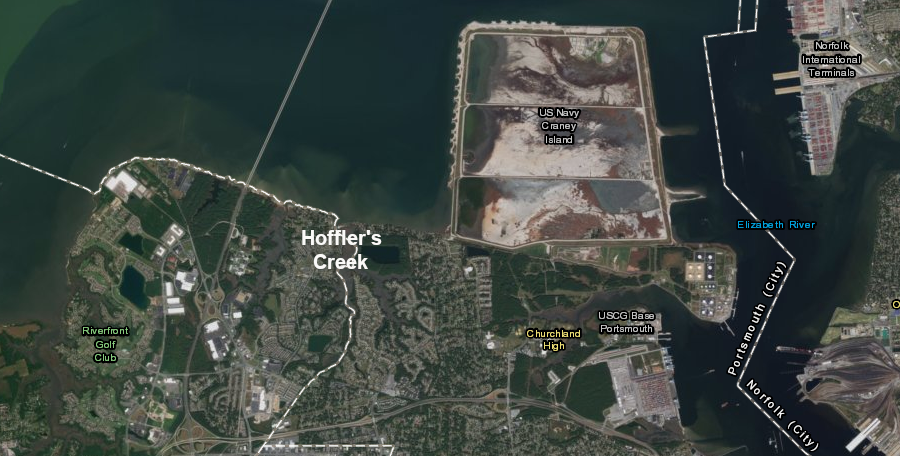
Hoffler's Creek and Craney Island have been transformed since the Battle of Craney Island in 1814
Source: ESRI, ArcGIS Online
The British took out their revenge of that loss on Hampton three days later, attacking and occupying that city between June 25-27, 1813. The Independent Companies were assigned to outpost duties, and were not under the direct supervision of British officers.
The French units were undisciplined, and both enlisted men and officers deserted. An unusually uncontrolled level of looting and rape occured:6
An English officer wrote in his diary:7
When challenged in a letter from an American officer to explain the behavior of the British forces, a different British officer defended the actions by claiming they were justified retaliation. The officer asserted that American cruelty during the battle at Craney Island justified what happened at Hampton as appropriate retaliation:8
A British officer made a claim which the Americans declared to be false:9
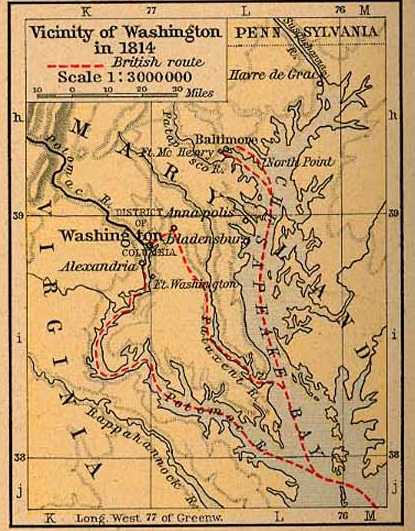
the British raided up the Potomac River in 1814, reaching Alexandria after the burning of public buildings in Washington
Source: Perry-Castaneda Library Map Collection, Campaigns of the War of 1812 ("Historical Atlas" by William R. Shepherd, 1923)
Though war was declared in 1812, the British were stretched thin by the war in Europe and North America until Napoleon was defeated in 1814. During the 1813 Chesapeake Bay expedition, Colonel Sir Sidney Beckwith had only 2,000 soldiers in Bermuda that he could use in the American campaign.
One way to gain extra manpower was to recruit French soldiers who had been captured in Europe, and French conscripts who had deserted to the British. Those French prisoners/deserters who were willing to serve in the British Army were organized into Independent Companies of Foreigners. Two companies totaling 300 men were sent to Bermuda and then North America.
As in the American Revolution, during the war of 1812 British forces were willing to carry enslaved men, women, and children away from their white "owners" in Virginia. The British organized formerly enslaved men in the Corps of Colonial Marines, comparable to the Ethiopian Regiment created by Lord Dunmore in the American Revolution in November 1775. On April 2, 1814, Alexander Cochrane issued a proclamation saying in part:10
Over 3,000 of the enslaved workers escaped to British lines, many to ships that intentionally recruited them. In addition to reducing the labor force of the American opponents, the recruitment forced white men in Virginia and Maryland to stay home. Instead of joining the American army or the militia, slaveowners had to patrol their local area to prevent escapes:11
Of the 3,600 African Americans recruited into the Corps of Colonial Marines, 550-700 were deployed as fighters known as "Blue Jackets." The rest of the recruits were used as laborers. The Corps of Colonial Marines were based on Tangier Island, where they built Fort Albion.
The first raid by the Corps of Colonial Marines was up Pungoteague Creek on the Eastern Shore. British officers were favorably impressed by the skills of the soldiers.12
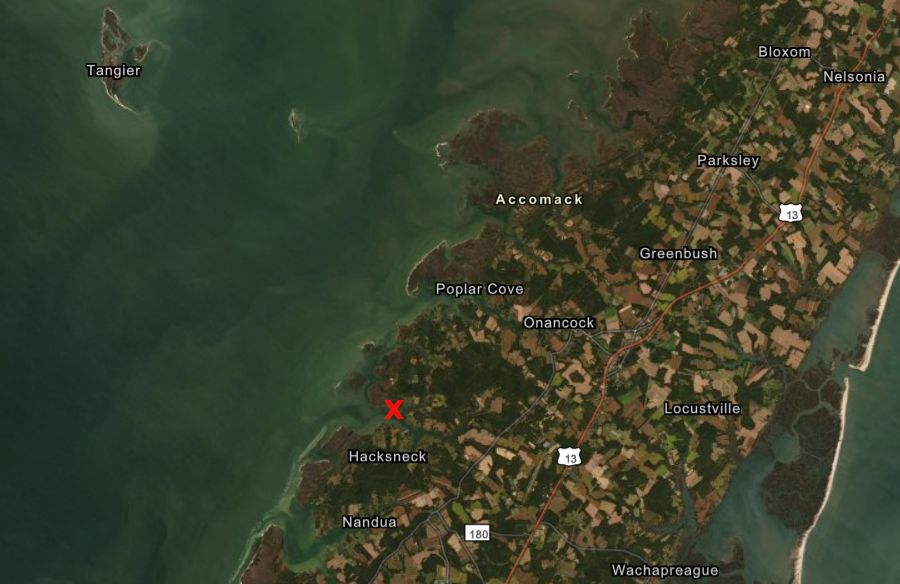
the first raid of the Corps of Colonial Marines was up Pungoteague Creek, north of Hacks Neck on the Eastern Shore
Source: ESRI, ArcGIS Online
The British Navy launched a three-pronged attack from the Chesapeake Bay in August, 1814. One fleet sailed up the Potomac River, a second headed towards Washington DC via the Patuxent River on the way to Baltimore, while a third raided along the northern edge of the Chesapeake Bay.13
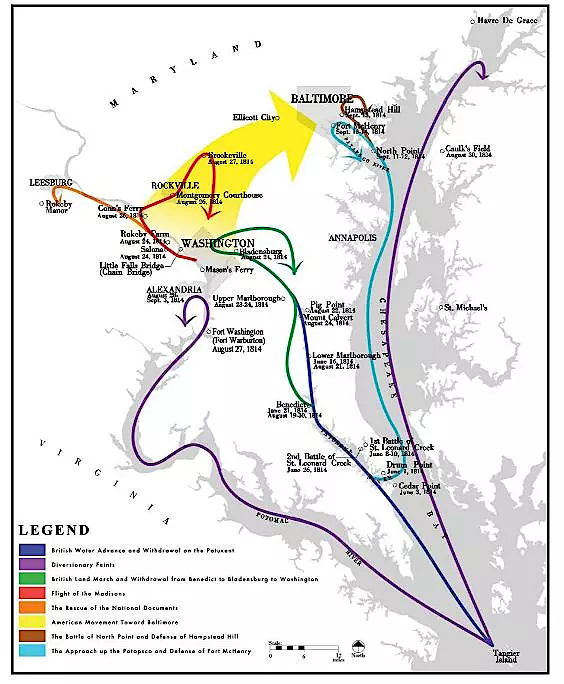
the primary target of the British Navy in August, 1814 was Baltimore
Source: National Park Service, The fall of Fort Washington and the Battle of White House Landing
Alexandria was occupied in August 28-September 3, 1814, after the British sailed up the Potomac River as another force marched through Maryland and occupied Washington, DC. During the five days of occupation, the British loaded tobacco, flour, and cotton from the warehouses onto captured American merchant ships.
The terms under which Alexandria's common council surrendered to the British were:14
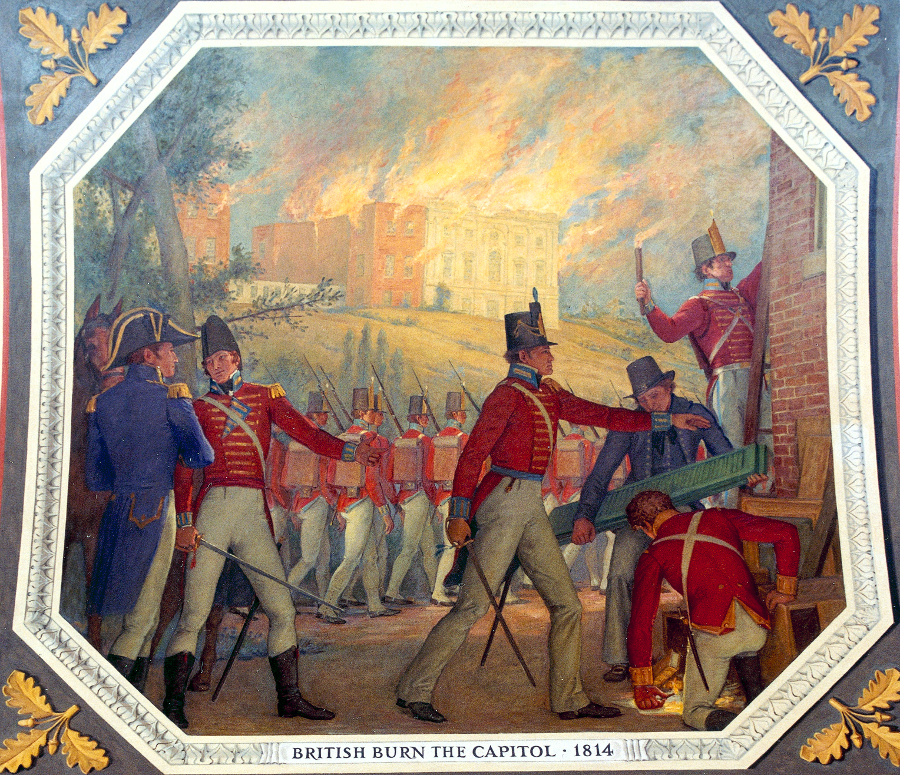
after the British Army burned public buildings in Washington DC, Alexandria surrendered to a fleet and allowed its warehouses to be looted
Source: Architect of the Capitol, British Burn the Capitol, 1814
British forces landed at Benedict, Maryland, head of navigation on the Patauxent River, on August 19, 1814. They marched to Washington and burned the public buildings there, including the White House and the Capitol.15
The December 1814 Treaty of Ghent ended the War of 1812, though news did not reach North American until after the Battle of New Orleans in January, 1815. The treaty was ratified by both sides in February 1815. the USS Constellation was finally able to sail out of the Elizabeth River on March 15, 1815.
Source: The History Chap, The USA - British War of 1812 - A British Perspective
Since the war was over, the British removed whatever materials they could from Fort Albion and burned the rest before sailing to Bermuda. A dispute over what the British removed from Tangier Island was not settled until 11 years later.
Article 1 of the treaty included:16
Source: WGTE Public Media, A Battle for the Northwest Frontier | Toledo Stories: War of 1812 in the Old Northwest
The definition of "property" included the enslaved Americans who had fled to the British during the war. When American commissioners arrived at Tangier Island to demand return of people who had escaped slavery, citing Article 1, the British official there reported to his superiors:17
Rear Admiral Cockburn refused to abandon the members of the Corps of Colonial Marines or the families that had reached Tangier Island. He issued orders that "em>on no account a single negro be left except by his request" for those who had reached Tangier by 4:00pm on February 17, 1815, the moment when the treaty was ratified.
Many enslaved people had already been transported away from Tangier Island before the American Commissioners arrived. James Monroe, the US Secretary of State, send representatives to Nova Scotia, the West Indies, and Bermuda with the intent of interviewing formerly enslaved people and asking if they wanted to return. The hope was that British treatment was so harsh that a voluntary return to enslavement was preferable, but none chose that option.
The Americans claims under Article 1 were disputed for years by the British, and in 1818 Czar Alexander I of Russia agreed to serve as arbitrator. In 1822, he determined that most of the American claims were valid. In 1826 the British finally paid $1.2 million in compensation. None of the those who escaped slavery were forced to return to the United States. In essence, the British financed freedom for over 3,000 people.18
When Francis Scott Key wrote the third verse of "The Star Spangled Banner," now the national anthem, he expressed joy that the American success at Fort McHenry was a defeat for the British effort to recruit enslaved men:19
Key was comfortable with the institution of slavery, and did not view the escape of enslaved people to the British as a search for freedom. After the War of 1812, he was District Attorney in the District of Columbia. Key prosecuted abolitionists who distributed pamphlets mocking the national capital as "land of the free, home of the oppressed" rather than the "the land of the free and the home of the brave.20
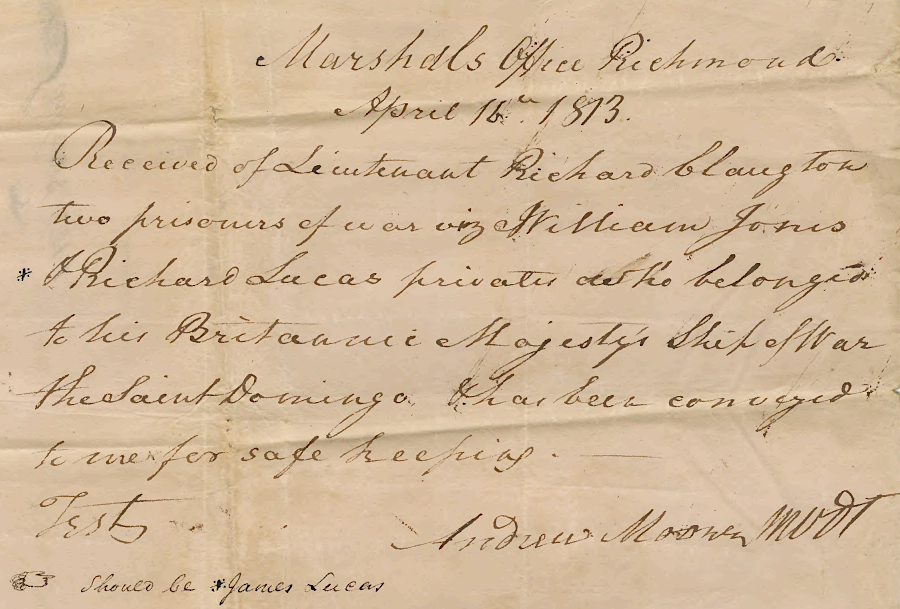
British prisoners from the HMS Saint Domingo were transported from Northumberland County to Richmond in April, 1813
Source: Library of Virginia, War of 1812 Bicentennial Collection

in 1814, British ships launched this 194-pound bomb at an American gun battery located on what is now Fort Belvoir
Source: Fairfax County Park Authority, The Bomb that Didn't Burst in Air
Source: Foreign Policy Research Institute, The Surprising Strategic Consequences of The War of 1812
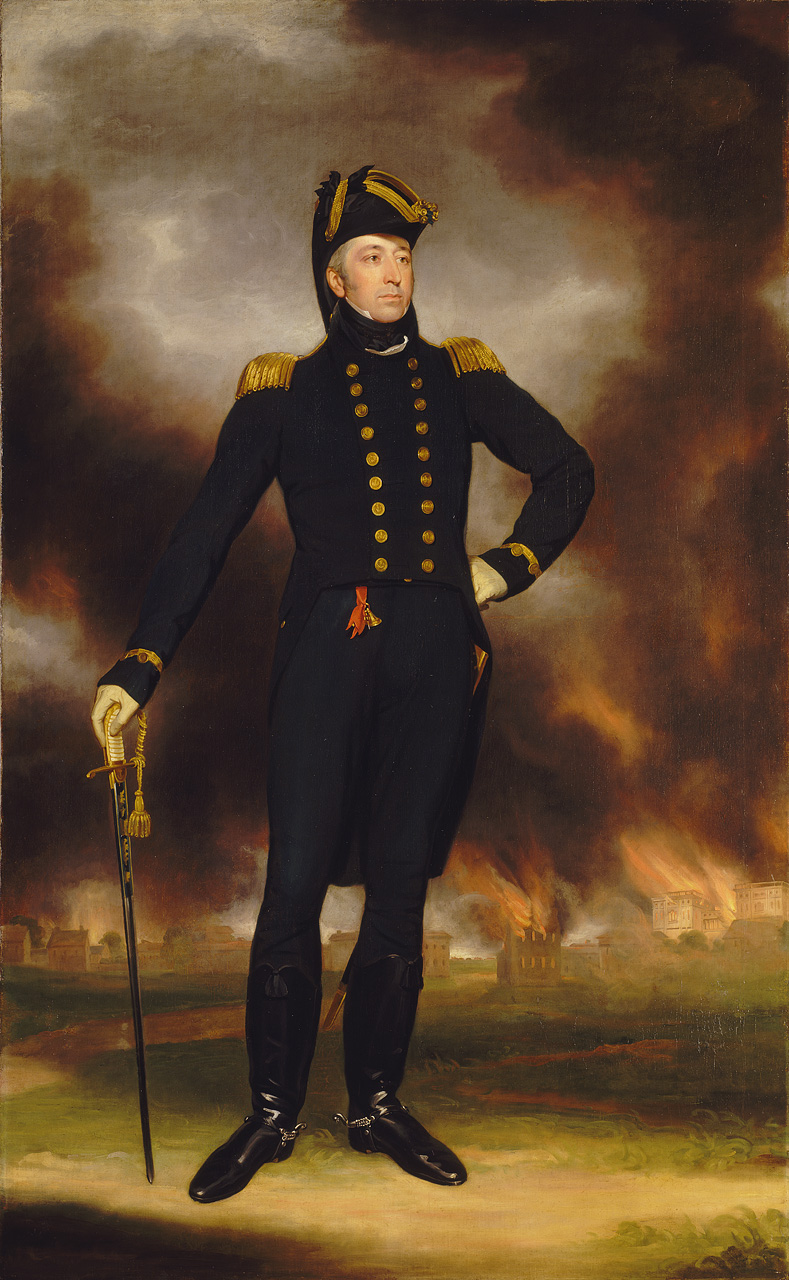
Admiral Cockburn commemorated the burning of Washington in 1814, not the plundering of Alexandria
Source: Fairfax County Park Authority, Rear-Admiral Sir George Cockburn, 1772-1853